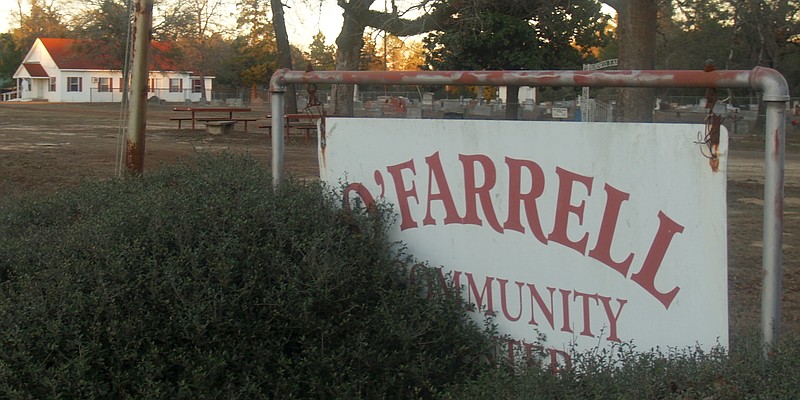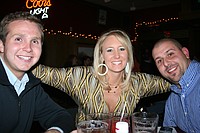O'Farrell seems forlorn without its community center that burned a year ago this month. Early on the morning of Feb. 16, 2016, lightning struck a tree and tumbled flaming limbs onto its roof. In 1994, the former Methodist church was remodeled into a red-and-white community center by residents and neighbors. Today, insurance money has been collected but there is no clear path forward. A new community center would require upkeep, and the community's cemetery of 562, which is close by, also needs perpetual care.
"We're not young any longer. There's few of us to rebuild, and a building needs continual care. Our funds for the cemetery haven't grown. Maybe we should use the money to create a perpetual care cemetery fund," said Sharon Autrey, cemetery association secretary, putting the dilemma forward.
But without a center of some kind, O'Farrell hardly exists. Its population was 43 in 1980, 20 in 2000 and 20 again in 2010.
It does have pleasant, meaningful memories. It was once one of the prettiest places in the county. A vineyard stands there now.
And so, an important cemetery association meeting is to be held this first Sunday in June.
Where?
Perhaps in the Baptist Church building, which is often closed but still remains nearby.
The Baptists were close to the Methodists in O'Farrell. In fact, in the days when O'Farrell had a store, gin and post office, the two churches were within 200 yards of each other. The congregations attended each other's revivals. Sometimes even shared the minister.
They also sang with their Sunday morning windows open to hear whose singing sounded better.
"The Baptists did," Ross Griffin mentions modestly, even though his grandmother Lulu Griffin played the Methodist piano.
O'Farrell's Methodist church dated to 1884. It closed in 1968 because of poor attendance. At its final worship service, just three attended.
In 1993, the Methodists gave the church and several acres of land to the community cemetery association.
Five acres of the land for the church had been donated by Fannie Cole Crawford in 1890. Drew Bruce built the building and then held his wedding there with Willie O'Rear. It was the first wedding with a public ceremony in the community, it was said, for in those days weddings were held in homes.
The community remodeled the church building when it became owned by the cemetery association. A host of names are associated with the effort. Work crews made of people with debts to pay to the county court system came to help. Many community fundraisers were held.
A veranda-style front porch was added with, of course, kitchen and bathrooms.
Katy Pate summarized the work done by writing in 1994 that "septic tank and water lines were installed, foundation restored, building steam cleaned, cabinets installed, public address system added, sign in front, flag pole moved, outside lights and shrubs placed, stove, refrigerator, butane tank, air-conditioning, blinds, windows and curtains."
The unusual circular propane tank placed out back was a gift from the family of Mrs. O.H. Rood, who had died recently but had done much for the center and community.
The cemetery association met here, and at one time on the board presided over by Givens Wilson sat Faye Livingston, granddaughter of Fannie Cole Crawford, donator of the land.
One of O'Farrell's many claims to fame had been a helicopter visit to the grounds by Lyndon Baines Johnson in 1948, then campaigning for the national senate seat in competition with Coke Stevenson.
All sorts of political office seekers would come to the center to visit the rural folk. But no other like Johnson, the first to barnstorm using a helicopter. That new gimmick joined the hillbilly band and free barbecue as ways of attracting a crowd.
Johnson, it was said, would make from 13 to 30 landings each day for those two weeks, the length of time he could use or finance the Bell 47 helicopter.
He also had another trick. He would toss his cowboy hat out into the crowd which, of course, caused everyone to scramble for it. Little did they know, Johnson had assistants on the ground to catch or recover the hat. The new and unknown political figure couldn't afford losing too many $25 cowboy hats.
Today, Griff Griffin of O'Farrell remembers the helicopter because his mother, Christobel Griffin, was one of those given a free ride in it.
When the cemetery association was given the land and building, Helen Alexander of Atlanta's First United Methodist Church sat on the board of 13 overseers for the Methodist's Texas Annual Conference, Texarkana District.
She presented the case that the property should be donated to the community cemetery association. Rural centers were becoming popular at the time, a place for suppers, games, young adults and families.
"What would the saints who gave this property to the church want us to do with it?," she asked in one letter. "They are buried there in the O'Farrell Cemetery."
That is what had to be decided then and again now.


